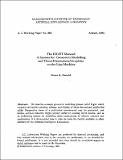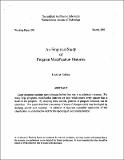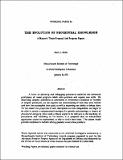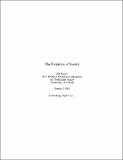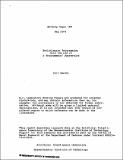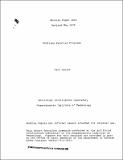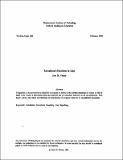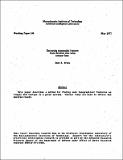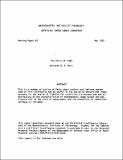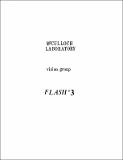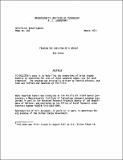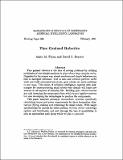Browsing AI Working Papers (1971 - 1995) by Title
Now showing items 65-84 of 291
-
The EIGHT Manual: A System for Geometric Modelling and Three-Dimensional Graphics on the Lisp Machine
(MIT Artificial Intelligence Laboratory, 1984-08)We describe a simple geometric modelling system called Eight which supports interactive creation, editing, and display of three-dimensional polyhedral solids. Perspective views of a polyhedral environment may be generated, ... -
An Empirical Study of Program Modification Histories
(MIT Artificial Intelligence Laboratory, 1983-03)Large programs undergo many changes before they run in a satisfactory manner. For many large programs, modification histories are kept which record every change that is made to the program. By studying these records, ... -
The Evolution of Procedural Knowledge
(MIT Artificial Intelligence Laboratory, 1975-01-16)A focus on planning and debugging procedures underlies the enhanced proficiency of recent programs which solve problems and acquire new skills. By describing complex procedures as constituents of evolutionary sequences of ... -
The Evolution of Society
(MIT Artificial Intelligence Laboratory, 1991-08-05)We re-examine the evolutionary stability of the tit-for-tat (tft) strategy in the context of the iterated prisoner's dilemma, as introduced by Axelrod and Hamilton. This environment involves a mixture of populations of ... -
Evolutionary Programming with the Aid of A Programmers' Apprentice
(MIT Artificial Intelligence Laboratory, 1979-05) -
Evolving Parallel Programs
(MIT Artificial Intelligence Laboratory, 1979-05)Message passing is directed toward the production of programs that are intended to execute efficiently in a computing environment with a large number of processors. The paradigm attempts to address the computational issues ... -
Exact Reproduction of Colored Images
(MIT Artificial Intelligence Laboratory, 1980-12)The problem of producing a colored image from a colored original is analyzed. Conditions are determined for the production of an image, in which the colors cannot be distinguished from those in the original by a human ... -
Exceptional Situations in Lisp
(MIT Artificial Intelligence Laboratory, 1985-02)Frequently, it is convenient to describe a program in terms of the normal situations in which it will be used, even if such a description does not describe the its complete behavior in all circumstances. This paper surveys ... -
An Experiment in Knowledge Acquisition for Software Requirements
(MIT Artificial Intelligence Laboratory, 1990-05)The Requirements Apprentice (RA) is a demonstration system that assists a human analyst in the requirements-acquisition phase of the software-development process. By applying the RA to another example it has been possible ... -
Extending 2-D Smoothed Local Symmetries to 3-D
(MIT Artificial Intelligence Laboratory, 1985-11)3-D Smoothed Local Symmetries (3-D SLS's) are presented as a representation for three-dimensional shapes. 3-D SLS's make explicit the perceptually salient features of 3-D objects and are especially suited to representing ... -
Extracting topographic features from elevation data using contour lines
(MIT Artificial Intelligence Laboratory, 1977-05)This paper describes a method for finding such topographical features as ridges and valleys in a given terrain. Contour lines are used to obtain the desired result. -
The Facts of Light
(MIT Artificial Intelligence Laboratory, 1975-05)This is a random collection of facts about radiant and luminous energy. Some of this information may be useful in the design of photo-diode image sensors, in the set-up of lighting for television microscopes and the ... -
A Fair Power Domain for Actor Computations
(MIT Artificial Intelligence Laboratory, 1979-06)Actor-based languages feature extreme concurrency, allow side effects, and specify a form of fairness which permits unbounded nondeterminism. This makes it difficult to provide a satisfactory mathematical foundation for ... -
Feature Point Generation Programs
(MIT Artificial Intelligence Laboratory, 1971)The programs in this set extract, from a raster of intensity values over some scene, a set of points which are adjudged to lie along the boundaries of objects in the scene. Intensities may be obtained directly from the new ... -
FED, the Font "EDitor" and Font Formats
(MIT Artificial Intelligence Laboratory, 1974-10)This memo describes FED, a program used for compiling and inspecting fonts: AST font format, a text format which can be used to create and edit fonts: and KST font format, the binary format used by SCRIMP, TJ6, and PUB. -
Finding Components on a Circuit Board
(MIT Artificial Intelligence Laboratory, 1973-09)This paper describes a set of programs written in LISP that recognize resistors on circuit boards. The approach leans heavily on a thorough examination of the features found in representative intensity arrays and on ... -
Finding the Skeleton of a Brick*
(MIT Artificial Intelligence Laboratory, 1973-03)TC-SKELETON's duty is to help find the dimensions of brick shaped objects by searching for sets of three complete edges, on for each dimension. The program was originally written by Patrick Winston, and then was refined ... -
The FINDSPACE Problem
(MIT Artificial Intelligence Laboratory, 1971-08-03)The FINDSPACE problem is that of establishing a volume in space where an object of specified dimensions will fit. The problem seems to have two subproblems: the hypothesis generation problem of finding a likely spot to ... -
Fine Grained Robotics
(MIT Artificial Intelligence Laboratory, 1991-02)Fine grained robotics is the idea of solving problems utilizing multitudes of very simple machines in place of one large complex entity. Organized in the proper way, simple machines and simple behaviors can lead to emergent ... -
Formalizing Reusable Software Components
(MIT Artificial Intelligence Laboratory, 1983-07)There has been a long-standing desire in computer science for a way of collecting and using libraries of standard software components. Unfortunately, there has been only limited success in actually doing this. We believe ...

